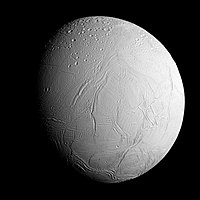Tsanfau II: Difference between revisions
Jump to navigation
Jump to search
No edit summary |
No edit summary |
||
| Line 5: | Line 5: | ||
| named_after = | | named_after = | ||
| adjectives = | | adjectives = | ||
| image = | | image = File:PIA17202_-_Approaching_Enceladus.jpg | ||
| image_size = | | image_size = 200 | ||
| caption = | | caption = | ||
| note = yes | | note = yes | ||
| Line 36: | Line 36: | ||
| mean_temp_2 = | | mean_temp_2 = | ||
| max_temp_2 = | | max_temp_2 = | ||
| atmosphere = | | atmosphere = | ||
| surface_pressure = | | surface_pressure = | ||
| atmosphere_composition = | | atmosphere_composition = | ||
}} | }} | ||
Tsanfau II is the second-largest moon of Tsanfau. It is about 690 kilometers (428 mi) in diameter. Tsanfau II is mostly covered by freshly created and relatively clean ice, because of this, it is a highly reflective object and thus is far colder than it would be otherwise. It's surface temperature has never been recorded higher than −196.2 °C (−385.16 °F). Despite its small size, Tsanfau II has some wildly diverse surface features, including old craters, ice scraps, ice sheets, and ice geysers, and a surprisingly dense atmosphere. | |||
Revision as of 01:54, 11 January 2022
 | |
| Discovery | |
|---|---|
| Discovered by | Allister Llloyd |
| Discovery date | 15 November 1799 at the
Layfet Colonial Observatory, Layfet, |
| Designations | |
| MPC designation | Tsanfau II |
| Orbital characteristics | |
| Satellite of | Tsanfau |
| Physical characteristics | |
Mean radius | 344/5 km |
| Mass | 1.911E+20 |
Mean density | 1.116 g/cm^3 |
| 0.107 m/s^2 | |
| 272.1 m/s | |
Tsanfau II is the second-largest moon of Tsanfau. It is about 690 kilometers (428 mi) in diameter. Tsanfau II is mostly covered by freshly created and relatively clean ice, because of this, it is a highly reflective object and thus is far colder than it would be otherwise. It's surface temperature has never been recorded higher than −196.2 °C (−385.16 °F). Despite its small size, Tsanfau II has some wildly diverse surface features, including old craters, ice scraps, ice sheets, and ice geysers, and a surprisingly dense atmosphere.